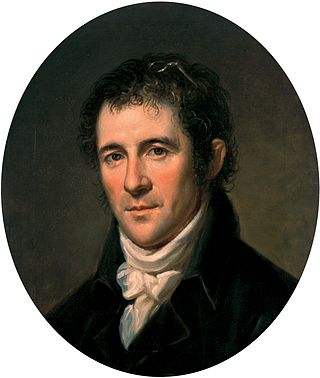
Benjamin Henry Boneval Latrobe was an Anglo-American neoclassical architect who immigrated to the United States. He was one of the first formally trained, professional architects in the new United States, drawing on influences from his travels in Italy, as well as British and French Neoclassical architects such as Claude Nicolas Ledoux. In his thirties, he immigrated to the new United States and designed the United States Capitol, on "Capitol Hill" in Washington, D.C., as well as the Old Baltimore Cathedral or The Baltimore Basilica,. It is the first Cathedral constructed in the United States for any Christian denomination. Latrobe also designed the largest structure in America at the time, the "Merchants' Exchange" in Baltimore. With extensive balconied atriums through the wings and a large central rotunda under a low dome which dominated the city, it was completed in 1820 after five years of work and endured into the early twentieth century.

The Baltimore and Ohio Railroad was the first common carrier railroad and the oldest railroad in the United States. It operated as B&O from 1830 until 1987, when it was merged into the Chessie System; its lines are today controlled by CSX Transportation.

The Chesapeake & Delaware Canal is a 14-mile (22.5 km)-long, 450-foot (137.2 m)-wide and 35-foot (10.7 m)-deep ship canal that connects the Delaware River with the Chesapeake Bay in the states of Delaware and Maryland in the United States.

George Washington Whistler was a prominent American civil engineer best known for building steam locomotives and railroads. He is credited with introducing the steam whistle to American locomotives.
Old Point Comfort is a point of land located in the independent city of Hampton, Virginia. Previously known as Point Comfort, it lies at the extreme tip of the Virginia Peninsula at the mouth of Hampton Roads in the United States. It was renamed Old Point Comfort to differentiate it from New Point Comfort 21 miles (34 km) up the Chesapeake Bay. A group of enslaved Africans was brought to colonial Virginia at this point in 1619. Today the location is home to Continental Park and Fort Monroe National Monument.

John Edgar Thomson was an American civil engineer and industrialist. An entrepreneur best known for his leadership of the Pennsylvania Railroad (PRR) from 1852 until his death in 1874, Thomson made it the largest business enterprise in the world and a world-class model for technological and managerial innovation. The railroad's first chief engineer became its third president.
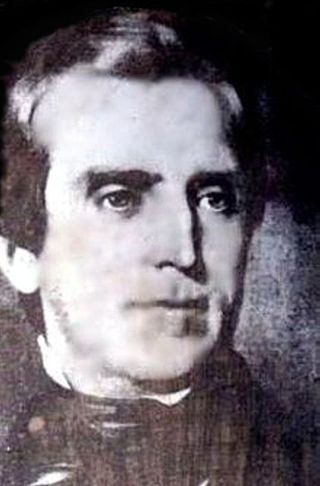
Moncure Robinson was an American civil engineer and railroad executive. He was one of the leading engineers for railroad survey and construction projects from the 1820s to the 1840s. He conducted surveys for and constructed multiple railroad lines including the Danville and Pottsville Railroad, the Allegheny Portage Railroad, the Chesterfield Railroad, the Petersburg Railroad, the Richmond and Petersburg Railroad, the Richmond, Fredericksburg and Potomac Railroad, the Winchester and Potomac Railroad, the Raleigh and Gaston Railroad, and the Philadelphia & Reading Railroad.
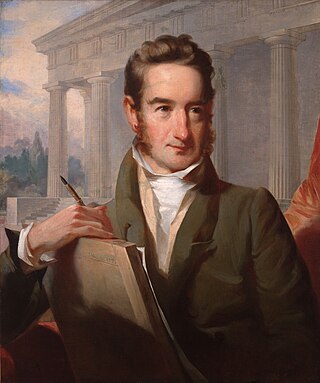
William Strickland was a noted architect and civil engineer in Philadelphia, Pennsylvania, and Nashville, Tennessee. A student of Benjamin Latrobe and mentor to Thomas Ustick Walter, Strickland helped establish the Greek Revival movement in the United States. A pioneering engineer, he wrote a seminal book on railroad construction, helped build several early American railroads, and designed the first ocean breakwater in the Western Hemisphere. He was elected as a member of the American Philosophical Society in 1820.

The Philadelphia, Wilmington and Baltimore Railroad (PW&B) was an American railroad that operated independently from 1836 to 1881. Headquartered in Philadelphia, it was greatly enlarged in 1838 by the merger of four state-chartered railroads in three Mid-Atlantic states to create a single line between Philadelphia and Baltimore.
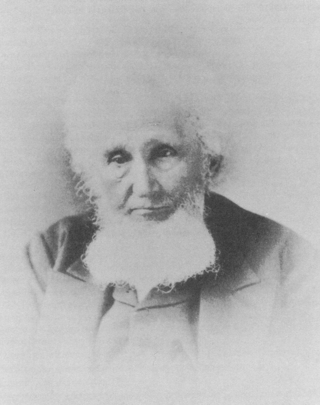
Ross Winans (1796–1877) was an American inventor, mechanic, and builder of locomotives and railroad machinery. He is also noted for design of pioneering cigar-hulled ships. Winans, one of the United States' first multi-millionaires, was involved in national and state politics, a southern-sympathizer and was a vehement "states' rights" advocate. Winans was briefly arrested after the Baltimore riot of 1861. His outspoken anti-federal stance as a member of the Maryland House of Delegates, the lower chamber of the General Assembly, led to his temporary arrest on May 14, 1861. At the time of his arrest, Winans was returning on a Baltimore and Ohio Railroad train from an early session of the legislature that was being held in the western Maryland town of Frederick to avoid the Union Army-occupied state capital of Annapolis in April–May 1861 to consider the possibilities of state secession during the early decisive period of the American Civil War. Winans was related to James McNeill Whistler through marriage.

The Thomas Viaduct spans the Patapsco River and Patapsco Valley between Relay, Maryland and Elkridge, Maryland, USA. It was commissioned by the Baltimore and Ohio Railroad (B&O); built between July 4, 1833, and July 4, 1835; and named for Philip E. Thomas, the company's first president. Some claim it to be the world's oldest multiple arched stone railroad bridge. However, the Sankey Viaduct on the Liverpool and Manchester Railway was opened in 1830, and finally completed in 1833.
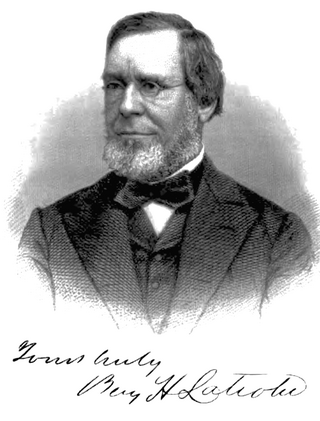
Benjamin Henry Latrobe II was an American civil engineer best known for his railway bridges and a railway executive.

Albert Fink was a German-born civil engineer who worked in the United States. He is best known for his railroad bridge designs, which helped revolutionize the use of iron for American railroad bridge construction. He devised the Fink truss and many truss bridges, especially the Fink-Type Truss Bridge.
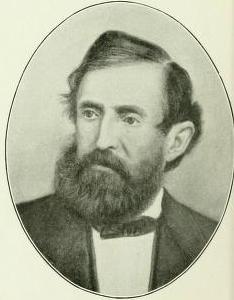
William Milnor Roberts was an American civil engineer. Roberts was one of the most prolific and prominent civil engineers of his generation in the United States. As a young civil engineer, he was involved in the construction of the Eads Bridge, held the title of the chief engineer of Northern Pacific Railroad, and was president of the American Society of Civil Engineers scarcely two decades after its founding,

James Crawford Neilson, or J. Crawford Neilson, was a Baltimore, Maryland-based architect. He was born in Baltimore, Maryland in 1816. After the death of his father in 1822 the family moved to England and in 1824 to Brussels. In 1833, he returned to Baltimore and in 1835, became a member of the survey party working on the Baltimore and Port Deposit Railroad,. His supervisor was Benjamin Henry Latrobe, II, (1806-1878), later supervising engineer on the Baltimore and Ohio Railroad,, son of an equally famous architect, Benjamin Henry Latrobe, (1764-1820). It was at this time that he first became acquainted with John Rudolph Niernsee, (1814-1885), while helping to survey in the area of Martinsburg, Virginia, for the Baltimore and Ohio Railroad.
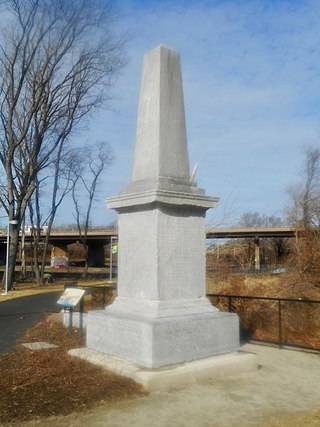
The Newkirk Viaduct Monument is a 15-foot (4.6 m) white marble obelisk in the West Philadelphia neighborhood of Philadelphia, Pennsylvania. It was installed in 1839 to mark the completion of the Newkirk Viaduct, the first permanent railroad bridge over the Schuylkill River. It is inscribed with the names of 51 railroad builders and executives, among other information.
Roswell Lyman Colt (1779-1856) was an American businessman who made a fortune in the shipping industry, served for decades as governor of the Society for Establishing Useful Manufactures, and was an early railroad executive.
Henry Roe Campbell was an American surveyor and civil engineer. Campbell contributed to American railroading and bridge-building in the first half of the 19th century. Campbell patented his 4-4-0 design in February 1836, just a few months before the patent law was changed to require that claims include proof of originality or novelty.

John Hazlehurst Boneval Latrobe was an American lawyer and inventor. He invented the Latrobe Stove, also known as the "Baltimore Heater", a coal fired parlor heater made of cast iron and that fit into fireplaces as an insert. He patented his design in 1846. The squat stoves were very popular by the 1870s and were much smaller than Benjamin Franklin's Franklin stove.
John McKim Jr. was an American merchant and early railroad executive based in Baltimore, Maryland.